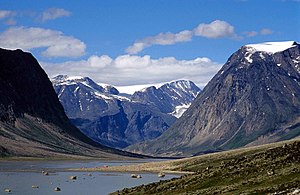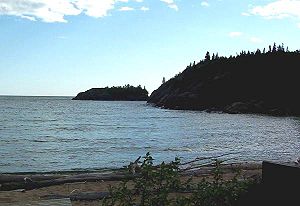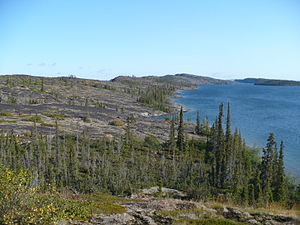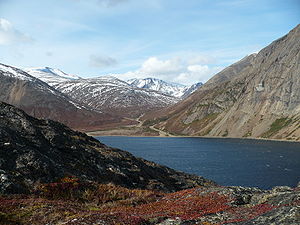The National Parks of Canada, and some (but not all) of the National Historic Sites of Canada, are managed by Parks Canada, an agency of the Government of Canada. If, when you picture Canada in your mind, you see vast wildernesses and mountain vistas, you are thinking of the national parks, one of the largest systems of protected areas in the world. As well, there are numerous historic sites protected by Parks Canada, some of which are also accessible by the general public.
Understand

The national parks cover more than 328,000 km² (126,000 sq mi), or about 3.3% of the total land area of Canada. Together, Canada's national parks are larger than Norway.
Beginning with Banff National Park in 1885, the federal government of Canada began putting aside scenic pieces of land aside for tourism. To this later were added more remote areas, where conservation rather than recreation are the focus. The parks range in size and amenities from small and highly developed areas on the edge of cities to vast wildlands the size of many European countries, but without any permanent population. Entrance to the parks are controlled by tollgates on the highways leading to them (if any), and one must pay to get in, or in some cases you can transit through a park, but have to pay to leave the highway.
It is not only the federal (central) government that operates parks in Canada. Each province also runs numerous provincial parks, some of which are equally or more famous than their federal cousins, such as Algonquin Provincial Park in Ontario or Kananaskis Country in Alberta. Confusingly, the provincially-owned parks in the often nationalistic province of Quebec, are also called "national parks"; for example Gaspésie National Park and Miguasha National Park are not federal, but rather provincial parks, despite the name.
There are two notable parks which are administered by other branches of the federal government, not Parks Canada. Both are free to enter, so a Parks Canada pass isn't needed. They are:
- 1 Gatineau Park, a major recreational attraction in the Outaouais region of Quebec (part of the National Capital Region (Canada) near Gatineau and Ottawa)
- 2 The Battlefields Park (Parc des Champs-de-Bataille) A major urban park and site of the 1759 Battle on the Plains of Abraham in which the British conquered Quebec City (Quebec Region, Central Quebec, Quebec).
National Parks
There are 38 federally-operated National Parks, nine National Park Reserves, three National Marine Conservation Areas (NMCAs), one NMCA Reserve and one National Landmark. A shaded background indicates the park is part of a UNESCO World Heritage List site. National Park Reserves are areas subject to indigenous land claims, their exact status and boundaries are therefore not considered permanent, but for a traveller they operate much the same as a full national park; on this list they are indicated by "(Reserve)".
National Historic Sites
Parks Canada also operates some (but not all) of Canada's National Historic Sites. A few are located within national parks, such as Banff or Jasper. Others among the more than 170 sites operated by Parks Canada include:
- 1 Alexander Graham Bell National Historic Site — Baddeck, Nova Scotia
- 2 L'Anse aux Meadows — abandoned Viking settlement on Newfoundland's Great Northern Peninsula
- 3 Bar U Ranch — Longview, Alberta
- 4 Batoche — former village and Louis Riel battle site near Prince Albert, Saskatchewan
- 5 Bellevue House — Kingston, Ontario
- 6 Cape Spear — easternmost point in Canada, near St. John's, Newfoundland - site of Cape Spear Lighthouse National Historic Site
- 7 Chilkoot Trail — Chilkoot, British Columbia
- 8 Dredge No. 4 — Bonanza Creek, near Dawson City, Yukon
- 9 Dawson Historical Complex and 10 SS Keno — Dawson City, Yukon
- 11 Forges du Saint-Maurice — Trois-Rivières, Quebec
- 12 Fort Anne and Scots Fort, Annapolis Royal, Nova Scotia
- 13 Fort Battleford — Battleford, Saskatchewan
- 14 Fort Beauséjour — Aulac, New Brunswick
- 15 Fort George and 16 Fort Mississauga — Niagara-on-the-Lake, Ontario
- 17 Fort Langley National Historic Site — Langley, British Columbia
- 18 Fortress of Louisbourg — Nova Scotia
- 19 Fortifications of Québec — Quebec City, Quebec
- 20 Fort Wellington and 21 Battle of the Windmill National Historic Site — Prescott, Ontario
- 22 Grand-Pré National Historic Site — former Acadian settlement, Nova Scotia
- 23 Green Gables Heritage Place — Cavendish, Prince Edward Island (PEI)
- 24 Grosse Isle — a quarantine station inundated with immigrants fleeing the Irish Potato Famine of the 1840s, Quebec
- 25 Halifax Citadel and 26 York Redoubt — Halifax, Nova Scotia
- 27 Hopedale Mission, Nunatsiavut, Labrador
- 28 Lachine Canal — Montréal, Quebec
- 29 Laurier House — Ottawa, Ontario
- 30 Lower Fort Garry — Selkirk, Manitoba
- 31 Red Bay — historic whaling station and archaeological site, Labrador
- 32 Rideau Canal — from Ottawa to Kingston (Ontario)
- 33 Riel House and 34 The Forks — Winnipeg, Manitoba
- 35 Rocky Mountain House, Alberta and 36 York Factory — Manitoba -- former Hudson's Bay Company posts
- 37 Signal Hill — St. John's, Newfoundland
- 38 SS Klondike — Whitehorse, Yukon
- 39 Stanley Park — Vancouver, British Columbia
- 40 Trent-Severn Waterway — (Trenton to Port Severn) and Peterborough Lift Lock, Ontario
Various smaller sites are listed in their host cities.
National Landmark
- 49 Pingo National Landmark — located 5 km west of Tuktoyaktuk in the Northwest Territories.
Park entry fees
Most Canadian national parks collect an entry fee; Canadian residents and international visitors pay the same price regardless of citizenship or place of residence. A few national parks are close to other parks (such as Banff National Park or Yoho National Park, mountain parks on the Alberta-BC border); it is possible to visit several parks in the same day and only pay once as the paid entry fee is valid until 4PM the following day.
Visitor fees are used to enhance and maintain the parks and visitor services; they do not go to general government revenues.
Youth and children up to the age of 17 are allowed free admission to all national parks.
If visiting Canadian national parks for a week or more, or visiting more than a half-dozen national parks and national historic sites in a calendar year, it may be less expensive to purchase an annual Discovery Pass.
Parks Canada Passes
The Discovery Pass provides unlimited admission for a full year at over 80 Parks Canada places that charge a daily entrance fee. It provides faster entry and is valid for 12 months from date of purchase. Prices for 2020 (taxes included):
- Family/group (up to 7 people in a vehicle): $136.40
- Children and youth (0-17): free
- Adult (18-64): $67.70
- Senior (65 ): $57.90
The Cultural Access Pass: people who have received their Canadian citizenship in the past year can qualify for free entry to some sites.
A Discovery Pass includes admission to national historic sites operated by Parks Canada, such as the Banff Park Museum, Cave and Basin National Historic Site, Bar U Ranch, Rocky Mountain House National Historic Site and Fort Langley National Historic Site.
Parks Canada does not operate all of Canada's national historic sites. To add confusion, Québec uses "parc national" for both federal and provincial (SÉPAQ) parks, which are two separate systems with non-interchangeable system passes. Due to its international, divided status the Thousand Islands has both a Canadian national park and an American state park, part of separate systems.
Reservations
Campgrounds may be reserved in advance. Reservations open in January for the next Apr 1-March 31 period. Reservations are available from www.reservation.parkscanada.gc.ca or 1-877-RESERVE ( 1-877-737-3783, 8AM-6PM local time); Parks Canada general information is provided at 1-888-773-8888.
Respect
In short: Leave-no-trace camping is always advised in National Parks.
Disturbing wildlife is illegal in a national park. Leave rocks, plants, bones and antlers as you found them. A few parks contain archaeological sites or are in ecologically-sensitive locations such as the high Arctic. You may need to pack out any rubbish with you when you leave; if there are no latrines in a sensitive location, excrement should be packed out or buried. Anything left behind in the far north may take a very long time to decay, if it's biodegradable at all.
Some parts of the parks are restricted to protect wildlife; for instance, if a beachfront nesting habitat for endangered birds is not accessible to the public, it is left undisturbed with no roads into the protected segments.
Many parks are in remote or forested locations with essentially no local firefighting capability. A cook stove is preferable to an open camp fire, due to risk of wildfires. Keep any fires small enough to burn to ash before you leave. Never build a fire on moss or Arctic tundra where it can spread underground.
Do not leave markers, messages or other manmade indicators behind; leave the parkland in its natural, untouched state for the next voyager. In some wilderness locations without marked permanent camp sites, leave-no-trace camping is advised.
A few parks in remote far northern locations like Ellesmere Island or the Torngat Mountains require visitors register on entry and notify the park office on departure. Failure to deregister (or leave a message indicating your party successfully completed its trip) risks the launch of a very expensive and awkward search if authorities mistakenly believe you are still stranded in the park.
Stay safe
Help is not always close at hand. Parks Canada sites vary from beaten-path (such as the Rideau Canal in Ottawa or the Anne of Green Gables site in Prince Edward Island National Park) to almost next-to-impossible destinations (such as Nunavut and the high Arctic). In some places, a satellite phone may be the only communication in an emergency and GPS the only waypoint or location marker. A national 24-hour emergency dispatcher may be reached in Jasper, Alberta at 1 780-852-3100 (freephone: 1-877-852-3100) if attempts to contact a local park office fail, but it may take days for help to arrive in adverse conditions in a truly remote location accessible only by aircraft.
As adverse weather may delay your departure from a remote location; it's best to carry a few extra days worth of provisions.
If heading far from the beaten path, leave an itinerary with intended route locations, activities and date of expected return, names of all visitors and guides in the group (with emergency contact info for each) and description of major identifiable equipment (like tents or watercraft).
Dangerous animals are a hazard; you are on their turf, so be bear aware. Foodstuffs may need to be packaged in bear-resistant containers. Significant restrictions dictate who may carry firearms in national parks. By necessity, Parks Canada allows specially-licensed guides, natives or researchers to carry firearms for protection from polar bears in nine of the parks: Ivvavik and Vuntut (northern Yukon), Aulavik and Tuktut Nogait (Northwest Territories), Quttinirpaaq (Ellesmere Island, Nunavut), Sirmilik and Auyuittuq (Baffin Island, Nunavut), Torngat Mountains National Park (Labrador) and Wapusk National Park (north of Churchill, Manitoba). The bears are a protected species at risk but, if warning shots, flares, air horns or pepper spray fail to scare bears away from humans, the armed native bear guards are empowered to use lethal force to protect human life.





























.jpg/300px-Lake_of_Shining_Waters_-_Prince_Edward_Island_National_Park_(22492133101).jpg)

















